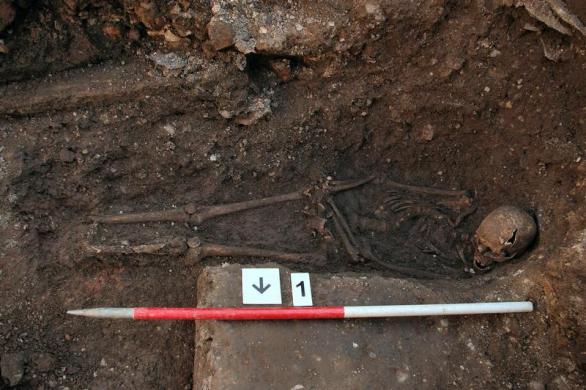 England – Scientists say they have found the 500-year-old remains of England’s King Richard III under a parking lot in the city of Leicester.
England – Scientists say they have found the 500-year-old remains of England’s King Richard III under a parking lot in the city of Leicester.
Subscribe to our Daily Roundup Email
University of Leicester researchers say tests on a battle-scarred skeleton unearthed last year prove “beyond reasonable doubt” that it is the king, who died at the Battle of Bosworth Field in 1485, and whose remains have been missing for centuries.
“Richard III, the last Plantaganet King of England,” has been found,” said the university’s deputy registrar, Richard Taylor.
Osteologist Jo Appleby said Monday that the study of the bones provided “a highly convincing case for identification of Richard III.”
And DNA from the skeleton matches a sample taken from a distant living relative of Richard’s sister.
The last English monarch to die in battle, Richard was depicted in a play by William Shakespeare as a hunchbacked usurper who left a trail of bodies — including those of his two princely nephews, murdered in the Tower of London — on his way to the throne.
Many historians say that image is unfair, and argue Richard’s reputation was smeared by his Tudor successors. That’s an argument taken up by the Richard III Society, set up to re-evaluate the reputation of a reviled monarch.
“It will be a whole new era for Richard III,” the society’s Lynda Pidgeon said. “It’s certainly going to spark a lot more interest. Hopefully people will have a more open mind toward Richard.”
Richard III ruled England between 1483 and 1485, during the decades-long tussle over the throne known as the Wars of the Roses. His brief reign saw liberal reforms, including introduction of the right to bail and the lifting of restrictions on books and printing presses.
His rule was challenged, and he was defeated and killed at the Battle of Bosworth Field by the army of Henry Tudor, who took the throne as King Henry VII.
For centuries, the location of Richard’s body has been unknown. Records say he was buried by the Franciscan monks of Grey Friars at their church in Leicester, 100 miles (160 kilometers) north of London. The church was closed and dismantled after King Henry VIII dissolved the monasteries in 1538, and its location eventually was forgotten.
 Then, last September, archaeologists searching for Richard dug up the skeleton of an adult male who appeared to have died in battle. There were signs of trauma to the skull, perhaps from a bladed instrument, and a barbed metal arrowhead was found between vertebrae of the upper back.
Then, last September, archaeologists searching for Richard dug up the skeleton of an adult male who appeared to have died in battle. There were signs of trauma to the skull, perhaps from a bladed instrument, and a barbed metal arrowhead was found between vertebrae of the upper back.
The remains also displayed signs of scoliosis, which is a form of spinal curvature, consistent with contemporary accounts of Richard’s appearance, though not with Shakespeare’s description of him as “deform’d, unfinished,” hunchback.
Researchers conducted a battery of scientific tests, including radiocarbon dating to determine the skeleton’s age. They also compared its DNA with samples taken from a London cabinet-maker identified as a 17th great-grand-nephew of the king’s older sister.
The mayor of Leicester, Peter Soulsby, said the monarch would be interred in the city’s cathedral.

Well, now we can all put that one to rest.
Mafia job!
🙂
I will sleep better now that this hath been resolved.
My Kingdom for a hearse.
“the study of the bones provided “a highly convincing case for identification of Richard III.”
Actually, he was easy to identify. From what I’ve read, Richard III was unusually ugly even by English standards.
Does anyone know where in Leicester this skeleton was found? I wander if it was anywhere near Jewry Wall? (the wall of the mikvah of Leicester circa: 1200)
Arrangements are currently in the process to have him reburied with a royal funeral followed by a feast fit for a king.
BTW anyone notice any gold jewlery on the skeleton?
I think it’s fascinating. I recently read a book about Richard III so I’m really interested in this significant find. For historians & interested lay people, it’s riveting stuff.